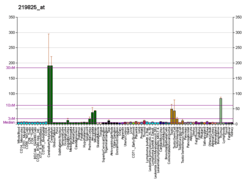CYP26B1
Cytochrome P450 26B1 is a protein that in humans is encoded by the CYP26B1 gene.[5][6]
This gene encodes a member of the cytochrome P450 superfamily of enzymes. The cytochrome P450 proteins are monooxygenases that catalyze many reactions involved in drug metabolism and the synthesis of cholesterol, steroids and other lipids. The enzyme encoded by this gene is involved in the specific inactivation of all-trans-retinoic acid to hydroxylated forms, such as 4-oxo-, 4-OH-, and 18-OH-all-trans-retinoic acid.[6]
In a developing mouse embryo, CYP26B1 is expressed in the distal tip of the forming limb bud with an abundance in the apical ectodermal ridge. In a knockout mouse model, mice manifest with severe limb malformations and die after birth due to respiratory distress.[7] However, if the expression of CYP26B1 is conditionally deleted only prior to E9.5, the limbs are not as severely truncated and more digits are visible. Research suggests that this difference is attributable to the timing of chrondroblast differentiation.[8]
CYP26B1 has been shown to be over-expressed in colorectal cancer cells compared to normal colonic epithelium. CYP26B1 expression was also independently prognostic in patients with colorectal cancer and strong expression was associated with a poorer outcome.[9]
In a genome-wide study, CCHCR1, TCN2, TNXB, LTA, FASN, and CYP26B1 were identified as loci associated with a risk for developing esophageal squamous cell carcinoma. Of these loci, CYP26B1 exhibited the highest effect size. Moreover, the CYP26B1 locus was found to have two alleles with differing capacities to catabolize all-trans retinoic acid, a chemotherapeutic agent. When the allele with the higher catabolic capacity, rs138478634-GA, was overexpressed, cell proliferation was significantly enhanced in comparison to the other allele, rs138478634-GG. Additionally, research is suggestive of a lifestyle interaction where individuals with the risk allele who partake in smoking or drinking present with an odd-ratio over 2-fold higher than smokers or drinkers without the variant or individuals who refrain.[10]
References
- GRCh38: Ensembl release 89: ENSG00000003137 - Ensembl, May 2017
- GRCm38: Ensembl release 89: ENSMUSG00000063415 - Ensembl, May 2017
- "Human PubMed Reference:". National Center for Biotechnology Information, U.S. National Library of Medicine.
- "Mouse PubMed Reference:". National Center for Biotechnology Information, U.S. National Library of Medicine.
- Nelson DR (Dec 1999). "A second CYP26 P450 in humans and zebrafish: CYP26B1". Arch Biochem Biophys. 371 (2): 345–7. doi:10.1006/abbi.1999.1438. PMID 10545224.
- "Entrez Gene: CYP26B1 cytochrome P450, family 26, subfamily B, polypeptide 1".
- Yashiro K, Zhao X, Uehara M, Yamshita K, Nishijima M, Nishino J, Saijoh Y, Sakai Y, Hamada H (2004). "Regulation of retinoic acid distribution is required for proximodistal patterning and outgrowth of the developing mouse limb". Dev. Cell. 6 (3): 411–22. doi:10.1016/s1534-5807(04)00062-0. PMID 15030763.
- Dranse HJ, Sampaio AV, Petkovich M, Underhill TM (2011). "Genetic deletion of Cyp26b1 negatively impacts limb skeletogenesis by inhibiting chondrogenesis". J. Cell Sci. 124 (16): 2723–34. doi:10.1242/jcs.084699. PMID 21807937.
- Brown, Gordon; Beatriz Cash; Daniela Blihoghe; Petronella Johansson; Ayham Alnabulsi; Graeme Murray (2014-03-07). "The Expression and Prognostic Significance of Retinoic Acid Metabolising Enzymes in Colorectal Cancer". PLOS ONE. 9: e90776. doi:10.1371/journal.pone.0090776. PMC 3946526. PMID 24608339.
- Chang J, Zhong R, Tian J, Li J, Zhai K, Ke J, Lou J, Chan W, Zhu B, Shen N, Zhang Y, Gong Y, Yang Y, Zou D, Peng X, Zhang Z, Zhang X, Huang K, Wu T, Wu C, Miao X, Lin D (2018). "Exome-wide analyses identify low-frequency variant in CYP26B1 and additional coding variants associated with esophageal squamous cell carcinoma". Nat. Genet. 50 (3): 338–43. doi:10.1038/s41588-018-0045-8. PMID 29379198.
External links
- Human CYP26B1 genome location and CYP26B1 gene details page in the UCSC Genome Browser.
Further reading
- Rat E, Billaut-Laden I, Allorge D, et al. (2006). "Evidence for a functional genetic polymorphism of the human retinoic acid-metabolizing enzyme CYP26A1, an enzyme that may be involved in spina bifida". Birth Defects Res. Part a Clin. Mol. Teratol. 76 (6): 491–8. doi:10.1002/bdra.20275. PMID 16933217.
- Bowles J, Knight D, Smith C, et al. (2006). "Retinoid signaling determines germ cell fate in mice". Science. 312 (5773): 596–600. doi:10.1126/science.1125691. PMID 16574820.
- Hillier LW, Graves TA, Fulton RS, et al. (2005). "Generation and annotation of the DNA sequences of human chromosomes 2 and 4". Nature. 434 (7034): 724–31. doi:10.1038/nature03466. PMID 15815621.
- Gerhard DS, Wagner L, Feingold EA, et al. (2004). "The Status, Quality, and Expansion of the NIH Full-Length cDNA Project: The Mammalian Gene Collection (MGC)". Genome Res. 14 (10B): 2121–7. doi:10.1101/gr.2596504. PMC 528928. PMID 15489334.
- Strausberg RL, Feingold EA, Grouse LH, et al. (2003). "Generation and initial analysis of more than 15,000 full-length human and mouse cDNA sequences". Proc. Natl. Acad. Sci. U.S.A. 99 (26): 16899–903. doi:10.1073/pnas.242603899. PMC 139241. PMID 12477932.
- Trofimova-Griffin ME, Juchau MR (2002). "Developmental expression of cytochrome CYP26B1 (P450RAI-2) in human cephalic tissues". Brain Res. Dev. Brain Res. 136 (2): 175–8. doi:10.1016/S0165-3806(02)00305-X. PMID 12101034.
- Abu-Abed S, MacLean G, Fraulob V, et al. (2002). "Differential expression of the retinoic acid-metabolizing enzymes CYP26A1 and CYP26B1 during murine organogenesis". Mech. Dev. 110 (1–2): 173–7. doi:10.1016/S0925-4773(01)00572-X. PMID 11744378.
- White JA, Ramshaw H, Taimi M, et al. (2000). "Identification of the human cytochrome P450, P450RAI-2, which is predominantly expressed in the adult cerebellum and is responsible for all-trans-retinoic acid metabolism". Proc. Natl. Acad. Sci. U.S.A. 97 (12): 6403–8. doi:10.1073/pnas.120161397. PMC 18615. PMID 10823918.




